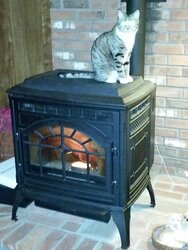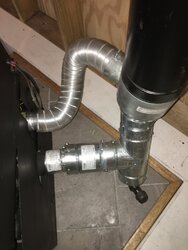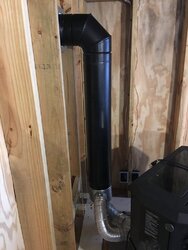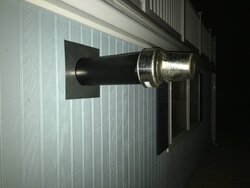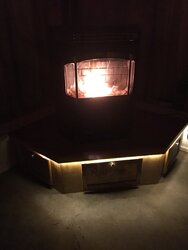OK Monica. Let me work on this. The make-up air flow still sounds low but I'll do some digging to see where it takes me. You are right that CFM in exhaust does not equal CFM in the OAK. This ratio will vary significantly because the heat transfer efficiency varies a lot between stoves and firing rates. I suspect that there is a pretty high fouling factor in most stoves under actual running conditions. The conversion factor of m^3/hr to CFM at 35 is correct. I cheated as I use both metric and imperial systems at work so I have ConvertPad on my phone. When I get to a conversion that's not on ConvertPad, I do it the old fashioned way....by hand.
Your stoich ratio number for wood is pretty close to what I have found on the net. It ranged from 4.58 for generic biomass to 5.75-6.3 for wood. My combustion book says 6.4 so I think that number is good. That's for air, not O2.
According to my Fossil Power Combustion book, "theoretical air" (A), or what's referred to as "stoich", for dry wood ranges from about 710-720 pounds of air per MMBTU of wood fuel. That does not include any excess air.
HHV of various species of wood, dry (in BTU/lb) of 8200-9800 BTU/lb.
Using pellets at 9000 BTU/lb you would need about 6.4 lb of air to combust 1 lb of pellets. At 30 deg F that would be about 79 ft^3 of air. Now add the excess air (15% excess O2) and you get 91 ft^3 per pound of pellets.
Just for comparison, the amount of air needed at 70 deg F (heated room air, not OAK) is 85 ft^3 w/o excess air and 98 ft^3 with 15% excess O2.
So that's just for 1 lb of pellets. Now multiply by the amount of pellets you burn per hour.
If we convert this to your example:
0.8 kg/hr = 1.76 lb/hr
1.76 X 91 ft^3 OAK air = 160 ft^3/hr
160 ft^3/hr = 2.7 CFM
Your math seems to check out. Surprising isn't it?
BTW, if it's cold, I burn twice that much. I also wouldn't be surprised if the efficiency isn't quite a bit lower than 80% in real life.
Regarding flue gas volume vs OAK air volume:
at 30 deg F (-1 deg C) air density is 0.081 lb/ft^3
at 70 deg F (21 deg C) air density is 0.075 lb/ft^3
at 300 deg F (149 deg C) air density is 0.052 lb/ft^3
......so on a mass flow basis this would make 2.7 ft^3/min equal to 0.22 lb/min at 30 deg F
and 0.22 lb/min at 300 deg F would be 4.23 Ft^3/min (CFM), so that's an increase of 56% in volume as the air heats up.
Now, something is rotten in Denmark. If most combustion fans are running at something like 20-30 CFM, per the experts, what does that tell us? Maybe there's a lot of tramp air coming in through the air wash for the glass? Maybe sneaking in somewhere else? It's hard to believe you could lose that much. I suspect most pellet stoves run at a much higher excess air number. For a well regulated industrial burner you would need 10-20% excess air to run efficiently. Most pellet stoves are pretty crude.
My apologies to the Danes for bringing them into this as this is pretty much a Franco-American thing.......
Anybody see any mistakes in my analysis?


